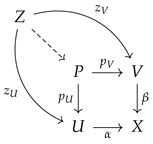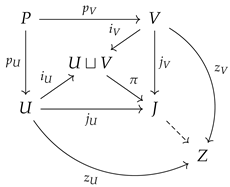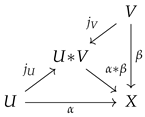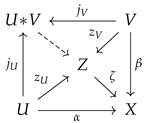1. Introduction
Diffeological spaces were introduced by Souriau [
1] as a generalization of differentiable manifolds. This setting includes not only finite-dimensional manifolds, but also manifolds with boundary, infinite-dimensional manifolds, leaf spaces of foliations, or spaces of differentiable maps. The main reference is Iglesias-Zemmour’s book [
2]. A recent survey is [
3]. Many fundamental results are also exposed in nLab [
4].
A diffeological structure on a set
X is given by declaring which maps from open subsets of Euclidean spaces
into X are considered to be smooth. These maps are called the
plots of the diffeology (
Section 2). They can be seen as
n-dimensional curves,
, on
X. This contravariant idea differs from the covariant classical one of declaring which real maps
from a manifold
X are smooth. On the other hand, the idea of an atlas on a manifold is generalized by considering a
generating family of plots (
Section 4).
Our main result (Theorem 2) will be to give a categorical interpretation of a generating family, namely by proving that the diffeological space is the join of the family, that is, the push-out of the pull-back. This establishes a connection between two seemingly unrelated ideas.
Most examples will be related to finite-dimensional manifolds.
2. Diffeological Spaces
A diffeology on the set X is a family of set maps called plots such that:
The domain of each plot is an open subset of some Euclidean space , ;
Any constant map belongs to the family ;
If belongs to and if is a -map, then the composition belongs to ;
The map belongs to if and only if it locally belongs to , that is, for each , there exists some open subset such that belongs to .
Note that the domain U and the Euclidean space , , depend on the plot .
A diffeological space is a set X endowed with a diffeology .
Remark 1. Diffeological spaces are considered to be of class . By changing by in axiom (3) for some , we could obtain a theory for the diffeological spaces of class .
Example 1. Let M be a finite-dimensional manifold. The manifold diffeology is the collection of all -maps defined on open subsets of Euclidean spaces with values in M.
Example 2. Let R be any equivalence relation on the manifold M and let be the quotient map. We endow the quotient set with the quotient diffeology where the map belongs to if it locally factors in some plot of the manifold diffeology on M.
Example 3. Let be any subset of the manifold M. We endow N with the subspace diffeology formed by the plots in the manifold diffeology such that .
The last two examples show that diffeology is a much more flexible setting than the classical one.
3. Smooth Maps
Definition 1. Let , be two diffeological spaces. A set map is smooth when implies .
Example 4. Let be -manifolds endowed with the manifold diffeologies , , respectively. Then, the smooth maps between M and N as diffeological spaces are the -maps as differentiable manifolds.
Proposition 1. The composition of two smooth maps is a smooth map.
Proposition 2. The quotient map of Example 2 is smooth. Moreover, a map is smooth if and only if the composition is smooth.
Corollary 1. A quotient map is a diffeomorphism if and only if it is bijective.
Proof. Let be the inverse map. Since is smooth, is smooth. □
Example 5. If is a subset endowed with the subspace diffeology of Example 3, then the inclusion map is smooth. Moreover, a map is smooth if and only if is smooth.
Example 6. By Axiom 3 of diffeology, the plots of a diffeology are smooth maps.
Definition 2. A diffeomorphism is a smooth map with a smooth inverse.
4. Generating Families
Definition 3. It is easy to check that the intersection of diffeologies on a set X is a diffeology on X. Then, if is any family of set maps we can consider the smallest diffeology containing . We will say that is a generating family for the diffeology .
We will assume that the collection contains all the constant plots.
Example 7. Any atlas on a manifold M is a generating family of the manifold diffeology.
Example 8. Let be a diffeological space and let be a set map. The diffeology on Y generated by the maps , with , is called the final diffeology. It is formed by the maps that are locally of the form for some .
Example 9. Let be a diffeological space and let be a set map. The initial diffeology on X is the diffeology generated by the set maps such that .
Example 10. Let , be two diffeological spaces. The product diffeology on is the intersection of the initial diffeologies for the projections and .
Example 11. The coproduct diffeology on the disjoint union is generated by the final diffeologies for the inclusions and .
It is easy to check that the product and coproduct diffeologies verify the usual universal properties.
The following criterion of generation is very useful.
Theorem 1 ([
2] Art. 1.68).
Let the diffeology be generated by the family . A set map belongs to if and only if it locally factors through some element of (we assume that constant plots are all contained in ).
Moreover, a map is smooth if and only if for any in a generating family of .
5. Categorical Constructions
The category of diffeological spaces and smooth maps has limits and colimits. Here, we will show how to construct the pull-back, the push-out, and the join of the two smooth maps. Most of time, these maps will be plots of some diffeology on
X. We refer to the recent paper [
5] for other categorical constructions.
5.1. Pull-Back
Let
,
be two smooth maps with the same codomain. The pull-back of
and
is the set
We endow it with the subspace diffeology of the product diffeology on
.
The projections
and
induce smooth maps
which verify
and the universal property of a pull-back:
5.2. Push-Out
Let
,
be two smooth maps with the same domain. The push-out of
and
is the quotient
of the coproduct
by the equivalence relation
R generated by
The maps
and
verify
and the universal property of a push-out:
5.3. Join
Given two smooth maps
and
, it is an exercise to check that the push-out of the pull-back of
and
is diffeomorphic to the join
of
and
[
6], defined as follows: there is a well-defined smooth map
and maps
and
such that
,
,
They verify the universal property
Analogously, given k maps , the join and the universal map are defined by induction.
Notice that, in the definition of the join, the maps and are arbitrary smooth maps, so for three plots , one can consider the join of the maps and .
Remark 2. It is possible to define the join of an infinite number of plots, but we will not develop this idea for the sake of simplicity.
Lemma 1. Let is a generating family. Then, the universal map of the join is a quotient map.
Proof. Let be a plot on X. By Theorem 1, for each , there exists a neighborhood such that factors through some . Hence, it factors through the disjoint union and consequently through the join. □
6. Main Result
Next, theorem is our main result.
Theorem 2. Let be a diffeological space. A family of plots is a generating family for if and only if there is a diffeomorphism commuting with the maps and the natural maps , that is, for all i.
Proof. Let be a generating family. The map is surjective because generating families include all constant plots.
It is injective because means that either or , and , that is, . Then, is bijective and Corollary 1 applies. Hence, is a diffeomorphism.
The converse statement follows from Lemma 1. □
Example 12. Let X be the disjoint union of a line and a point , endowed with the diffeology generated by the constant plot , , and the identity plot , , respectively. Clearly, .
Example 13. Let X be the setWe consider the diffeology on X generated by the two plotsThen, .
As we pointed out in [7], this is not the cross
diffeology on X induced by the manifold diffeology of .
Example 14. The manifold diffeology on a manifold M is the join of any atlas. More precisely, let be an atlas on the manifold . Thenwhere the open subsets are glued by inclusions.
7. Conclusions
The category of diffeological spaces and smooth maps contains smooth manifolds as a full subcategory but has better properties, such as having all limits and colimits. One basic idea, that of generating families, seems to have not been fully exploited, as we show in our main Theorem 2. This kind of result has applications in Cartan calculus (see [
7]).









